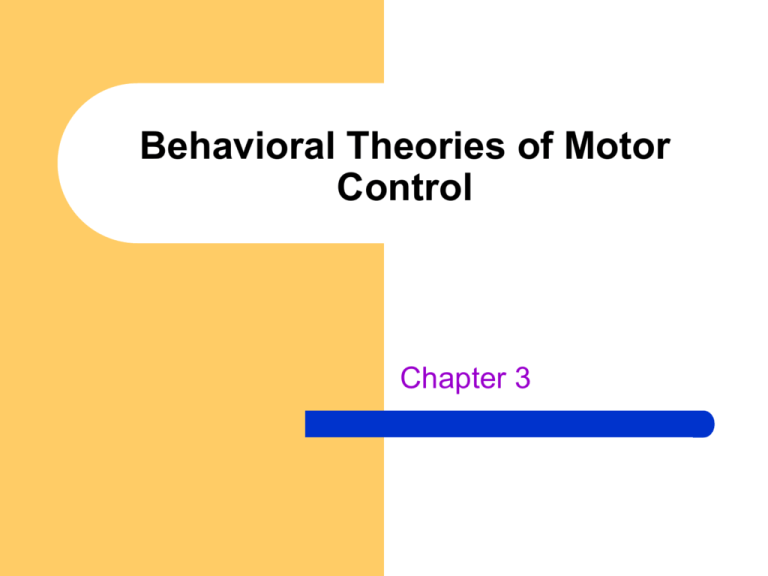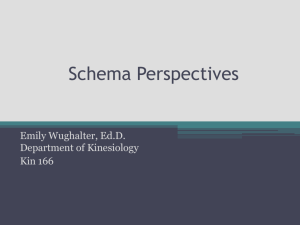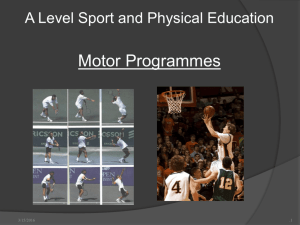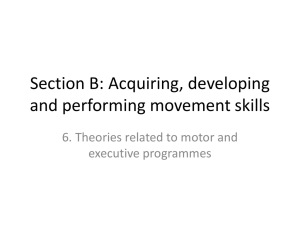Behavioral Theories of Motor Control
advertisement

Behavioral Theories of Motor Control Chapter 3 Overview Now that we’ve looked at response preparation, what happens during the response programming stage? Early Motor Program Theories Proposed that for each movement to be made, a separate motor program existed and was stored in memory Two problems: – Storage: Hard drive (brain) could run out of space – Novel responses: How do you respond to an action never done before? Command Center Decision> appropriate plan retrieved from memory> instructions to rest of body for action Open Loop Systems Open loop – Action plans generated by command center then carried out by the limbs and muscles without modification Command Center Action Mechanical Example:Sending Email Closed Loop Systems Closed loop – Command center generates action plan that initiates the movement – Feedback is used to modify on-going action Action Command Center Feedback Mechanical Example: Thermostat Slow Vs. Rapid Movements Motor control uses both open and closed loop systems – Movements are planned in advance, initiated & executed with little modification (remember the fake in PRP?) – If a rapid movement, feedback will be used for the next attempt – For slower movements, open loop begins the movement and closed loop will continue to completion Problem: How does a person do a novel motor skill? Motor Program – Abstract representation of a movement plan – Stored in memory – Issues instructions that are carried out by the limbs and muscles Generalized Motor Program (GMP) Represents a class of actions or pattern of movement that can be modified to yield various response outcomes Invariant features – Relatively fixed underlying features that define a GMP Parameters – Flexible features that define how to execute a GMP Fixed vs. Flexible Features Write your name with the following: – – – – – – Your dominant hand Your non-dominant hand Pen in your mouth Pressing very hard Pressing very soft Write quickly, then slowly Which aspects were fixed? Flexible? Invariant Features Relatively fixed underlying features – Sequence of actions or components – Relative timing – Internal rhythm of the skill : the amount of time to write each letter of your name will stay the same whether writing fast or slow Relative force Internal force relationship: The amount of force given to write each letter stays proportionally the same whether pressing hard or soft Parameters Adaptable features of program Easily modified from one performance to another to produce variations of a motor response – Overall duration: Fast or slow – Overall force: Hard or soft – Muscle selection: Writing with hand or foot? Review Question When swimmers use hand paddles or when baseball hitters swing heavier bats, does this manipulate invariant features or parameter features? – – When might such an action hinder the development of correct technique? What signs would you look for to avoid this problem? Schema Rule or relationship that directs decision-making when a learner is faced with a movement problem Developed by abstracting 4 sources of information for each performance attempt 1. Initial conditions present at start of movement 2. Response specifications: parameters used in the execution of the movement 3. Sensory consequences: what did the action feel like? 4. Response outcome: how successful was the response? Schema Development For each movement attempt the four sources of information are stored in memory briefly Feedback from the attempt verifies – – How successful was the performance? Do I need to change the movement? With each additional attempt, the strength of the schema increases when you compare one attempt to the next Motor Response Schema Recall schema – Responsible for organizing the motor program What do I need to do?>What conditions exist?>What parameters & invariant features are required?>Execute the response Recognition schema – Responsible for the evaluation of a movement attempt : Was the movement correct? Error signal updates the recall schema Dynamic System Theory Movement pattern is thought to emerge or selforganize as a function of the ever-changing constraints placed upon it Constraints Defined as the boundaries that limit the movement capabilities of an individual Three types – Organismic: structural or functional – – Body type, wt, ht Psychological, cognitive, emotional Environmental:wind, light, flat surface, grassy Task Task Constraints The goal of task: a certain movement Rules that may limit the movement – One must serve the tennis ball within an area on the baseline Implements or machines – Using a walker, using weight machines, using a ball Attractor States Systems prefer states of stability When a change in constraints is imposed on a system, its stability is endangered Deep basins = stable systems = difficult to change Shallow basins = less stable = more susceptible to change Phase Shifts Changes in behavior are the result of a series of shifts Control parameters – Variables that move the system into new attractor states: gaining leg strength to perform a skill better Rate limiters – Constraints that function to hinder or hold back the ability of a system to change :Adult learner, fear So what happens when a skill performance needs to change? Practice strategies need to create instability in a deep attractor basin – – As the skill moves through the phase shift, it will become a combination of the old and new ways At some point it will be neither the old or new and performance effectiveness is reduced Eventually through practice, a new attractor state is formed, and eventually a new deep basin Key Point Movement patterns prefer state of stability New movements self-organize and emerge with phase shifts where attractors stabilize and destabilize as a function of the control parameters Practical Application Explain how orthotics function from a dynamic system perspective Exit Slip How do the recall and recognition schema work together? How are phase shifts indicative of behavioral change?








